 |
BusTalk
A Community Discussing Buses and Bus Operations Worldwide!
|
| View previous topic :: View next topic |
| Author |
Message |
Mr. Linsky
BusTalk's Offical Welcoming Committee

Joined: 16 Apr 2007
Posts: 5071
Location: BRENTWOOD, CA. - WOODMERE, N.Y.
|
 Posted: Mon Sep 09, 2013 2:35 am Post subject: Posted: Mon Sep 09, 2013 2:35 am Post subject: |
 |
|
Here's a great late forties shot taken in front of Manhattan's Grand Central Terminal at 42nd. Street and Pershing Square (Park Avenue) where we see one of Carey Transportation's first Flxible Clipper Airporters - a Model 29B246 carrying a fleet number in the 200's and heading westbound as it travels from one curbside terminal to the next on its runs to New York's three major airports.
The taxi in the lead is a 1948 Packard Twenty-Second series using a 226 inch Super Eight seven passenger sedan stretch built for Packard by Henney Corporation of Freeport, Illinois
The Packard taxi was a major player in the New York market until Checker began to run away with the business in the early fifties also wiping out DeSoto's famous SkyViews at the same time.
While the tracks of the Third Avenue Railway System's (TARS) 42nd. Street Crosstown Line still show in the roadway, the cars themselves were replaced in 1946 by TARS affiliate Surface Transportation System as can be seen by the two GM TDH 4507's in the background.
All and All, a wonderful slice of mid town Manhattan back in the day!
Photo courtesy of 'Vintage-Vault75' and is available at eBay as item # 171121361161.
Mr. Linsky - Green Bus Lines, Inc., Jamaica, New York
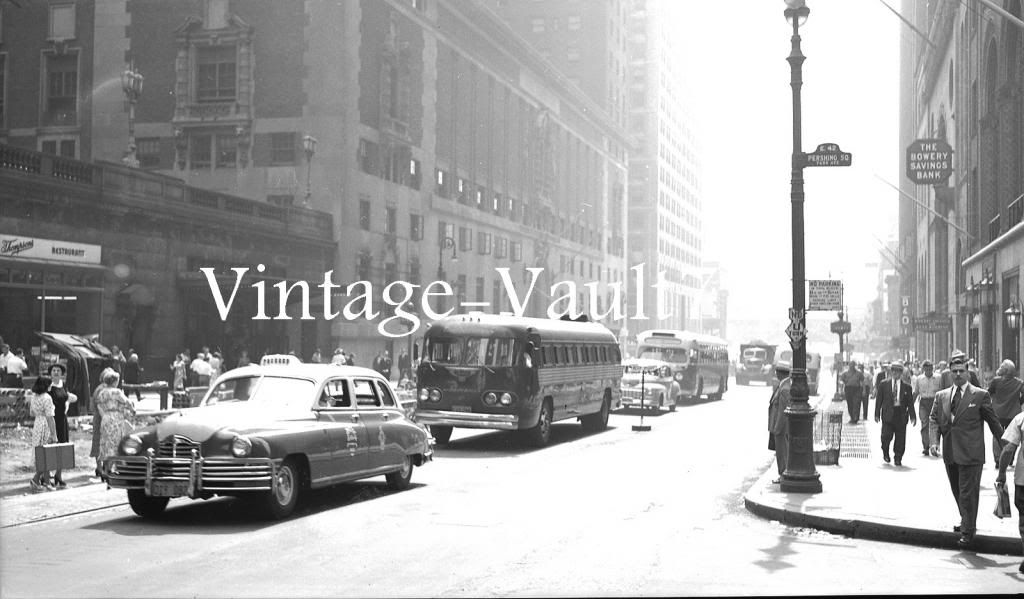 |
|
| Back to top |
|
 |
X-Astorian
Joined: 19 Feb 2009
Posts: 173
Location: Central NJ
|
 Posted: Mon Sep 09, 2013 9:15 am Post subject: Posted: Mon Sep 09, 2013 9:15 am Post subject: |
 |
|
| Mr. Linsky wrote: |
 |
Good one, Mr. L,
Based on the two lanes of traffic and the apparent disruption on the north side of 42nd Street, it looks like those TARS tracks are finally being removed. |
|
| Back to top |
|
 |
Hankg42
Age: 75
Joined: 19 Apr 2010
Posts: 94
Location: The Villages, FL
|
 Posted: Tue Sep 10, 2013 1:51 pm Post subject: Posted: Tue Sep 10, 2013 1:51 pm Post subject: |
 |
|
| The Bowery Savings Bank (on the right) at 110 E. 42nd St. was where I worked my first job as a "grown-up", starting in 1970. The building is a "Landmark" structure, and houses a Cipriani's catering business, for high-end events. Much beautiful marble of various types make up what used to be the "banking floor" where events are now held. |
|
| Back to top |
|
 |
Mr. Linsky
BusTalk's Offical Welcoming Committee

Joined: 16 Apr 2007
Posts: 5071
Location: BRENTWOOD, CA. - WOODMERE, N.Y.
|
 Posted: Wed Sep 18, 2013 4:26 pm Post subject: Posted: Wed Sep 18, 2013 4:26 pm Post subject: |
 |
|
Seen sometime in the early forties wending its way along route # R103 between the St. George Ferry Terminal and Tottenville via Tompkins Avenue and Hyland Boulevard is fleet #190 - a 1938 30 passenger ACF Model H-13-S operating for the Staten Island Coach Company (SICCO) of Staten Island, New York.
Introduced in 1934, ACF's Model H-13-S was not only the manufacturer's first genuine street car type but was also the first to have its engine placed underfloor amidships in the form of a gasoline fueled Hall-Scott (pancake design) model 166.
Unfortunately, ACF's persistence in continuing to offer underfloor gasoline configurations while other major manufacturers had long since opted for Diesels at the rear led to its demise in the early fifties.
A brief history of SICCO;
In March of 1937, and at behest of the City of New York, the Associated Gas and Electric Company created SICCO to replace with buses the borough's emergency trolley bus services that it had run under the supervision of the city's Department of Plant and Structures (DP&S).
SICCO operated a fleet of mixed 1930's ACF models including H-13's, H-17's, H-9's and a few 26-U's until 1946 when it sold the company to its employees who then formed Isle Transportation which immediately began to replace its aging ACF's with a new fleet of White 798's. However, further plans never materialized and the fledgling company fell into the hands of the city which then created the Staten Island Bus Division in 1947.
Of note on #190 is the fresh air intake over the second passenger window which fed a roof mounted fan housing for a full time ventilation system.
BTW; those are not this writer's initials carved under the windshield to the left of the right directional signal!
Photo courtesy of 'Vintage-Vault75' and has been sold on eBay.
Mr. Linsky - Green Bus Lines, Inc., Jamaica, New York
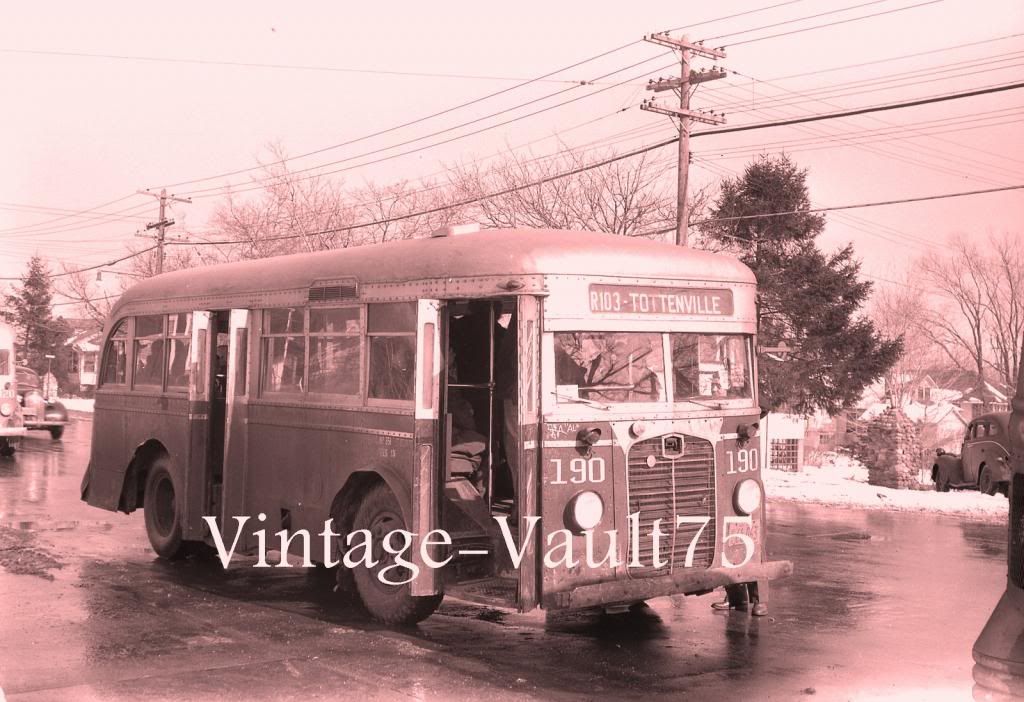 |
|
| Back to top |
|
 |
Mr. Linsky
BusTalk's Offical Welcoming Committee

Joined: 16 Apr 2007
Posts: 5071
Location: BRENTWOOD, CA. - WOODMERE, N.Y.
|
 Posted: Sat Sep 21, 2013 2:00 pm Post subject: Posted: Sat Sep 21, 2013 2:00 pm Post subject: |
 |
|
Here's another 'Golden Oldie' from ACF;
In this wintry 1948 photo of an interesting slice of the Borough of Kings, we see fleet # 858 - a 1938 35 passenger ACF Model H-17-S and one of 75 likenesses numbered 800 to 874 operating for the Brooklyn Bus Corporation (BBC) division of the Brooklyn-Manhattan Transit Corporation (BMT).
The ACF Model H-17-S is basically a stretched version (by one window) of the 30 passenger H-13-S described in detail in the Staten Island Coach #190 essay above and is identical mechanically as well as being one of the manufacturer's most popular pre war offerings with 551 built between 1935 and 1938.
The 800's, which were the next to last order for BBC, all met their fate with the crusher soon after this photo was taken and upon the arrival of hundreds of new city GM, Mack and Twin replacements.
# 858 is espied at Ryder Street trundling its way along the #5 Kings Highway Line to Cropsey Avenue.
Also seen Traveling south on Flatbush Avenue (right of frame) is a Schaefer Beer truck about to deliver 'the one beer to have when you're having more than one'! (courtesy of the F & M Schaefer Brewing Company, Brooklyn, New York).
Photo courtesy of 'Vintage-Vault75' and is available at eBay as item # 171131700864.
Mr. Linsky - Green Bus Lines, Inc., Jamaica, New York
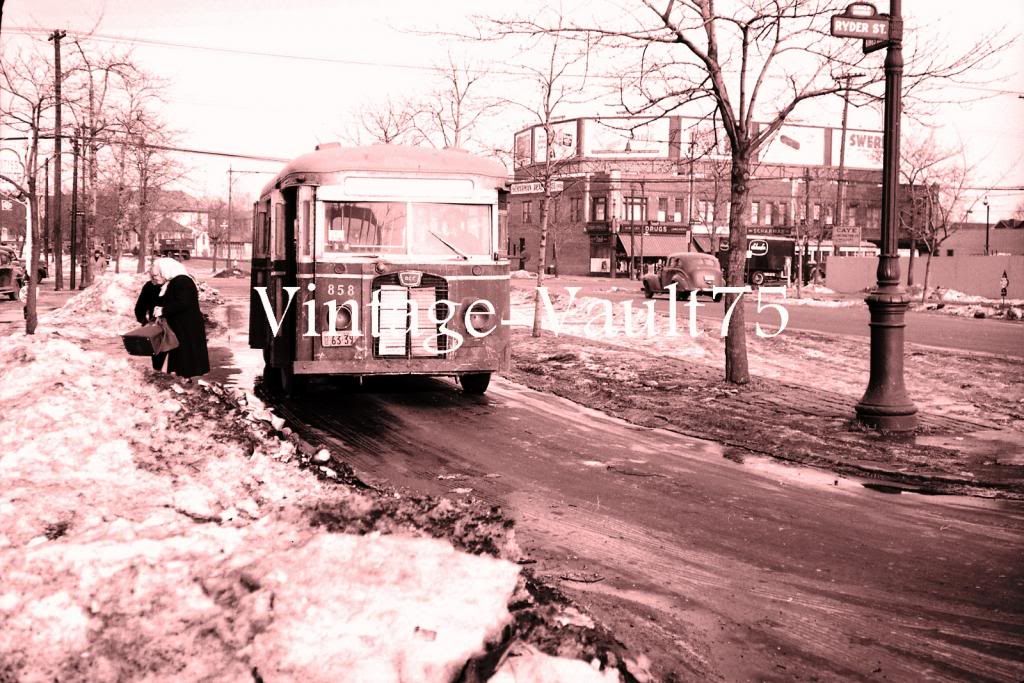 |
|
| Back to top |
|
 |
JimmiB
Age: 82
Joined: 19 Apr 2011
Posts: 516
Location: Lebanon, PA
|
 Posted: Sat Sep 21, 2013 10:37 pm Post subject: Posted: Sat Sep 21, 2013 10:37 pm Post subject: |
 |
|
| I like the cardboard "thermostat" on the grille. |
|
| Back to top |
|
 |
Q65A
Age: 68
Joined: 17 Apr 2007
Posts: 1796
Location: Central NJ
|
 Posted: Sun Sep 22, 2013 8:50 am Post subject: Posted: Sun Sep 22, 2013 8:50 am Post subject: |
 |
|
This photo reminds me just how far transit bus technology has come in the past 65 years.
Then as now, The Big Apple has been a tough proving ground for buses. |
|
| Back to top |
|
 |
Mr. Linsky
BusTalk's Offical Welcoming Committee

Joined: 16 Apr 2007
Posts: 5071
Location: BRENTWOOD, CA. - WOODMERE, N.Y.
|
 Posted: Sun Sep 22, 2013 2:27 pm Post subject: Posted: Sun Sep 22, 2013 2:27 pm Post subject: |
 |
|
Bob et al;
Don't get me wrong when I say that the ACF's of the 30's were probably among the best buses ever built and their march through the war years and far beyond that in many cases goes to prove the point.
But I also have to say that songwriter Jesse Stone (A.K.A. C. E. Calhoun) must have had the 'H' series ACF's in mind when he wrote 'Shake Rattle and Roll' because that's just what those buses reminded me of!
Regards,
Mr. 'L' |
|
| Back to top |
|
 |
Mr. Linsky
BusTalk's Offical Welcoming Committee

Joined: 16 Apr 2007
Posts: 5071
Location: BRENTWOOD, CA. - WOODMERE, N.Y.
|
 Posted: Tue Sep 24, 2013 2:00 pm Post subject: Posted: Tue Sep 24, 2013 2:00 pm Post subject: |
 |
|
Seen in 1948 at a location to be determined but within the limits of New York City is fleet # 1645 - a 1948 45 passenger Mack Model C-45-GT and one of fifty three likenesses numbered 1601 to 1653 delivered in increments between 1947 and 1948 to the City of New York Board of Transportation.
The gasoline powered 1600's (the first Macks to enter the city's fleet) were purchased specifically to operate the then B56 line between East New York, Brooklyn and Jamaica, Queens via Jamaica Avenue and began that service at 2:00 PM on Sunday November 30th. 1947 upon seeing the last trolley car head for the barn.
After a short run on the Brooklyn/Queens route the buses were transferred to Staten Island to augment GM 5101's in the replacement of pre war Staten Island Coach Company equipment.
Now for the mystery surrounding the location of the photo; (you've gotta follow the bouncing ball on this one!).
One the one hand, the identical photo appears on page 18 of 'Greller's NYCTS Bus & Trolley Coach Fleet 46 to 58' and is captioned along with other like Macks in the background as being on their way to the East New York Depot to begin their first assignment (note here that #1645 has no roll sign but does already have NYS Bus plates).
On the other hand, the eBay vendor selling the photo claims that it was taken in 1948 on Victory Boulevard in Staten Island (and this vendor is usually pretty accurate on detail).
Greller's captions leads us to believe that the buses were on their way from the Mack factory in Allentown, Pa. to East New York - the question, of course, becomes; what were they doing in Staten Island and how did they get to Brooklyn pre Verrazano Bridge?
Logic would dictate that any new buses from Mack going to Brooklyn from Allentown would catch Rt. 80 to the Holland Tunnel and cross Manhattan to Brooklyn via any of three East River bridges.
Also bear in mind that new buses coming from the factory would carry temporary Manufacturer's plates as did all GM's from Michigan.
So, the location and date of the photo is questionable.
Another question; before the Verrazano Bridge, how did the city get buses to Staten Island - did they go by barge or ferry or were they driven through the Holland Tunnel and down to the Goethals or Outer Bridge crossings.
You decide!
Photo courtesy of 'Vintage-Vault75' and is available ay eBay as item# 171131699699.
Mr. Linsky - Green Bus Lines, Inc., Jamaica, New York
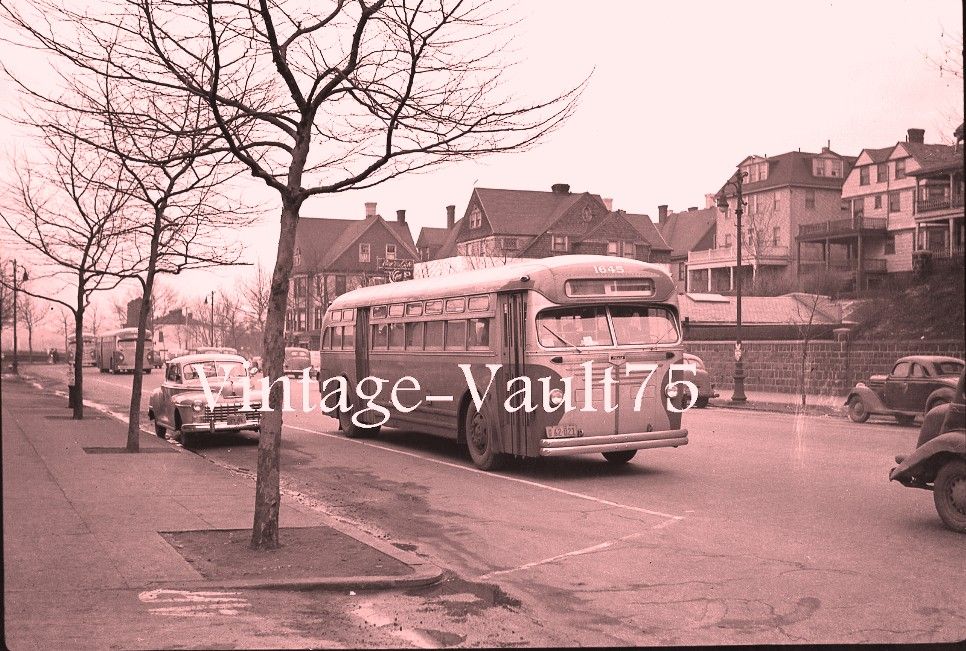 |
|
| Back to top |
|
 |
RailBus63
Moderator

Joined: 16 Apr 2007
Posts: 1063
|
 Posted: Tue Sep 24, 2013 7:38 pm Post subject: Posted: Tue Sep 24, 2013 7:38 pm Post subject: |
 |
|
| The driver is wearing a uniform and there appears to be at least one passenger in the bus. |
|
| Back to top |
|
 |
andy47
Joined: 17 Feb 2011
Posts: 96
Location: New York State
|
 Posted: Wed Sep 25, 2013 4:32 pm Post subject: Posted: Wed Sep 25, 2013 4:32 pm Post subject: |
 |
|
Mr. L:
You're right that coming from the Mack factory in Allentown PA the buses would cross the Hudson via the Holland (or Lincoln) Tunnel and then continue to Brooklyn on one of the East River bridges. But no way that Route 80 was used - it did not open till about 1963. Before that, from Allentown to North Jersey US Route 22 would have been the most likely route.
The location looks like Richmond Terrace in Staten Island - note the sea wall on the far left side of the photo. Does not look like Brooklyn near East New York.
Travelling between Staten Island and the rest of NYC my guess is the buses used one of the Hudson River tunnels and then the Bayonne or Goethals Bridge to access Castleton Depot, in those days new and the only bus depot on Staten Island at the time. Ferries would have been very time consuming and would have cost NYC the revenue derived from private cars using the boats. Plus only a set number of buses could have accommodated at any one time - unless a dedicated ferry was used that did not carry private cars or pedestrians. |
|
| Back to top |
|
 |
Mr. Linsky
BusTalk's Offical Welcoming Committee

Joined: 16 Apr 2007
Posts: 5071
Location: BRENTWOOD, CA. - WOODMERE, N.Y.
|
 Posted: Sun Sep 29, 2013 3:21 am Post subject: Posted: Sun Sep 29, 2013 3:21 am Post subject: |
 |
|
Seen in 1912 when new traversing Manhattan's Central Park on its run between upper Riverside Drive and Washington Square via the #5 line is fleet #201 - a 23 passenger De Dion-Bouton demonstrator operating for the Fifth Avenue Coach Company (FACCO) of Manhattan, New York.
Specialized chassis for buses were virtually non existent in the U.S. in the earliest part of the twentieth century so FACCO, one of the first (if not the first company) to motorize looked across the seas to already established manufacturers and found both Daimler of England and De Dion-Bouton of France as most likely candidates and, while some Daimler equipment did make the roster, De Dion became the mainstay (bodies for all of FACCO's early equipment were built by the J.G. Brill Company of Philadelphia, Pennsylvania).
It was the onset of World War I, when shipments of chassis from the two foreign sources were diverted to the war effort, that forced FACCO to begIn to manufacture its own underpinnings in their upper Manhattan shops not only for themselves but to any and all takers.
Mechanical field tests of #201 in early 1912 proved very favorable but the 23 seat capacity did not so subsequent orders in the 200 series in 1912 and 1913 added a 22 seat second level which began the famous double decked tradition that the company maintained until the last of its late thirties Queen Marys left the road in 1953.
The single deck #201 enjoyed its jaunts through Central Park, a privilege not afforded to its double deck cousins due to low overpass heights but that changed in 1914 when #201 was rebuilt to two levels itself.
BTW; note that FACCO's fare was 10 cents (twice the going trolley rate) - a lot of money for that day and age!
Photo courtesy of 'Forgotten Images' and is available at eBay as item #281177089771.
Mr. Linsky - Green Bus Lines, Inc., Jamaica, New York
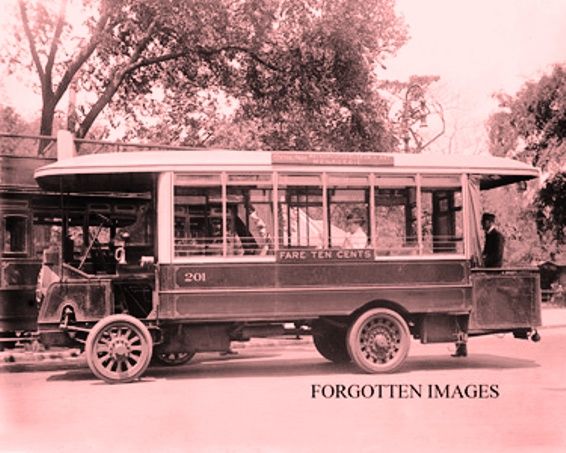 |
|
| Back to top |
|
 |
Mr. Linsky
BusTalk's Offical Welcoming Committee

Joined: 16 Apr 2007
Posts: 5071
Location: BRENTWOOD, CA. - WOODMERE, N.Y.
|
 Posted: Mon Sep 30, 2013 1:22 pm Post subject: Posted: Mon Sep 30, 2013 1:22 pm Post subject: |
 |
|
While transit buses of yore may not have seemed very comfortable to ride in with their sprung suspensions, some manufacturers more than made up for the deficit by providing 'living room' quality seating as can be seen below in the interior of a 1933 40 passenger Twin Coach Model 40 operating as #233 for Jamaica Buses of Baisley Park, New York.
Heavily cushioned plush genuine leather seating of what would be of 'Rolls-Royce' caliber today abounds with individually contoured benches amidships which were easily removable to service the underfloor 'twin' engines - certainly, no 'slash proofing' needed in those days!.
Of note is the Johnson Model 'J' electric fare box which was one of many that were transferred from the trolley cars of Jamaica's predecessor Jamaica Central Railways.
The blurb below, thanks to the Johnson Fare Box Company, illustrates the versatility of their Model J.
Photo courtesy of 'Judahpraise' and is available at eBay as item #121176996379.
Mr. Linsky - Green Bus Lines, Inc., Jamaica, New York
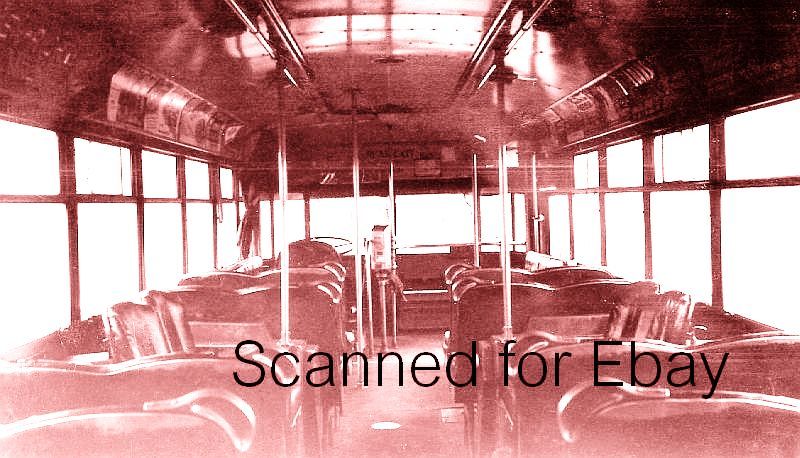
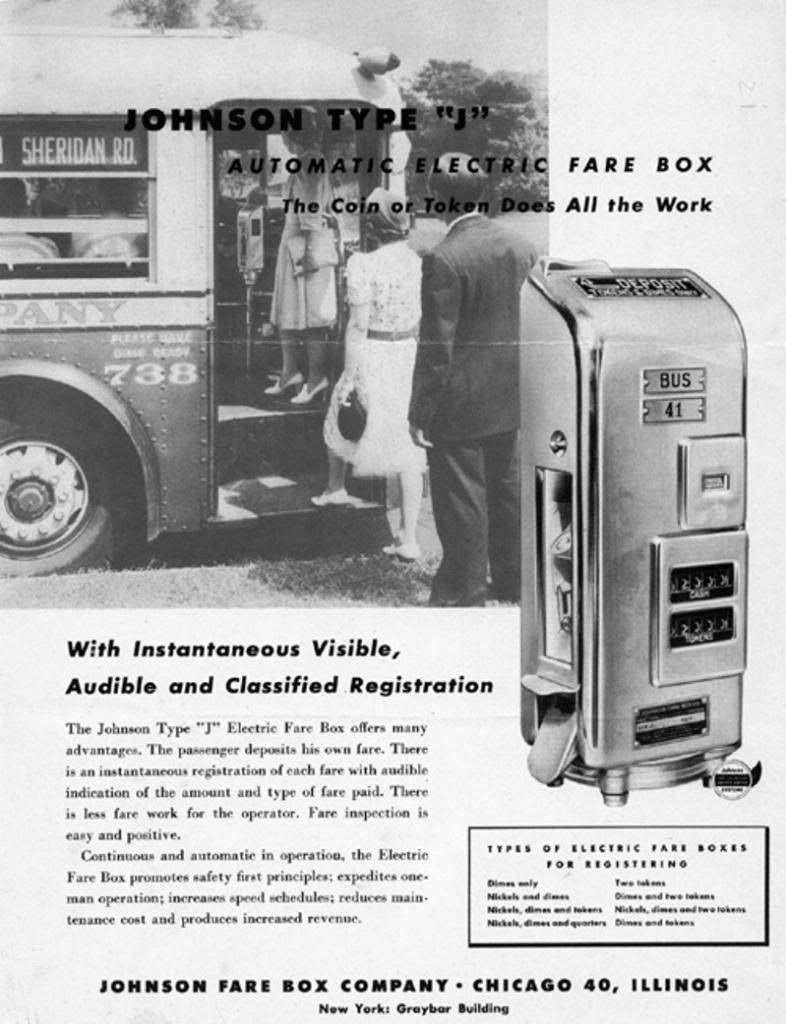 |
|
| Back to top |
|
 |
Hart Bus
Age: 75
Joined: 24 Apr 2007
Posts: 1150
|
 Posted: Mon Sep 30, 2013 2:24 pm Post subject: Posted: Mon Sep 30, 2013 2:24 pm Post subject: |
 |
|
| Just goes to show how much more civilized people were back then. With all the vandalism that goes on today could you imagine any transit (bus, subway or railroad) contemplating this kind of interior? |
|
| Back to top |
|
 |
Hankg42
Age: 75
Joined: 19 Apr 2010
Posts: 94
Location: The Villages, FL
|
 Posted: Tue Oct 01, 2013 7:55 am Post subject: Posted: Tue Oct 01, 2013 7:55 am Post subject: |
 |
|
| andy47 wrote: | Mr. L:
You're right that coming from the Mack factory in Allentown PA the buses would cross the Hudson via the Holland (or Lincoln) Tunnel and then continue to Brooklyn on one of the East River bridges. But no way that Route 80 was used - it did not open till about 1963. Before that, from Allentown to North Jersey US Route 22 would have been the most likely route.
The location looks like Richmond Terrace in Staten Island - note the sea wall on the far left side of the photo. Does not look like Brooklyn near East New York.
Travelling between Staten Island and the rest of NYC my guess is the buses used one of the Hudson River tunnels and then the Bayonne or Goethals Bridge to access Castleton Depot, in those days new and the only bus depot on Staten Island at the time. Ferries would have been very time consuming and would have cost NYC the revenue derived from private cars using the boats. Plus only a set number of buses could have accommodated at any one time - unless a dedicated ferry was used that did not carry private cars or pedestrians. |
I haven't been on the site for a week or so. While catching up, I came upon the picture of the Macks where the location is in doubt. While studying it, and before I came to Andy47's post, my guess was also Richmond Terrace in my old home town of Staten Island, NY. This was based, as Andy said, on the water to the left of the frame, and also the type of lamp post that appears there. Since the water is to the right of the bus, it would have been headed southbound on the terrace, which would have been toward the Castleton Depot, and away form the St. George ferry area. |
|
| Back to top |
|
 |
|
|
You cannot post new topics in this forum
You cannot reply to topics in this forum
You cannot edit your posts in this forum
You cannot delete your posts in this forum
You cannot vote in polls in this forum
You can attach files in this forum
You can download files in this forum
|
Powered by phpBB © 2001, 2005 phpBB Group
|









